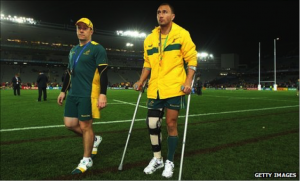
Having a quick look at the NRL injury list 21 of the total 73 injuries currently reported by NRL players are knee injuries. Is this bad luck or poor management? What can any active person do to reduce the risk of a knee injury slowing you down?
The knee is one of the largest joints in the body, and is quite complex. The knee is made up of three bones:
The movements that occur at the knee include a flexion and extension component (bending and straightening) as well as some rotation, which we describes as internally and externally rotating and translating forwards and backwards.
The knee acts as a force transfer between the hip and the ankle.
The ligaments of the knee provide stability and include:
We can’t forget there are two menisci, one on the inside and the other on the outside that act as shock absorbers through the joint.

The knee is a complex joint. This diagram is showing you all the stuff you find inside. It’s pretty amazing!
As you can see there’s a fair bit going on in the knee, an injury to the knee can affect one or many of the above structures, each of which plays a vital role.
Common injuries sustained are ligament tears or ruptures, depending on the force of the impact, the position of the knee and the type of movement involved numerous ligaments can be injured. If you are playing and every feel a pop or hear an audible noise it’s time to stop immediately. This is never a good sign and can indicate that you may have partially torn or ruptured one of your ligaments. Depending on the ligament you might require a knee brace, or if required surgery.
 If you every feel a catching or locking in your knee that is followed by pain or swelling, this can also be an indication of an internal injury, most likely your meniscus. Again if you notice these symptoms or have been playing with these symptoms you need to have your knee assessed to make sure you aren’t doing any further damage to your joint.
If you every feel a catching or locking in your knee that is followed by pain or swelling, this can also be an indication of an internal injury, most likely your meniscus. Again if you notice these symptoms or have been playing with these symptoms you need to have your knee assessed to make sure you aren’t doing any further damage to your joint.
Sharp pain underneath the patella (knee cap) or around the outside of your leg associated with swelling and tightness may be due to an issue with your knee cap, your ITB (iliotibial band), weakness in your VMO (quad muscle), weakness in your gluts (bum muscles) or some biomechanical deficiency that needs to be assessed and altered. Again, playing with sharp pain underneath or around the patella can lead to further problems and time off from sport if not addressed early.
Finally, if you are tracking well, and aren’t having any issues make sure that you maintain a strength and stretching program. Now that we are half way through the season niggles start to make their way to the front. A good stretching program consists of dynamic stretches such as hamstrings, gluts, quads and hip flexors and ITB rolling. A strength program will consist of glut strengthening (which is not necessarily heavy squats), quads strengthening and core stability exercises. Make sure you have a good mix between exercises that target muscles specifically as well as sports specific drills that can be tailored to your needs.
If you have any knee related queries please feel free to make an appointment to see one of our Physiotherapists who will be able to assess your knee and provide you with the most appropriate program moving forward.
Jude Holroyd – the author of this article is the Principal Physiotherapist at The Healthy Body Company, Jordan Springs.
